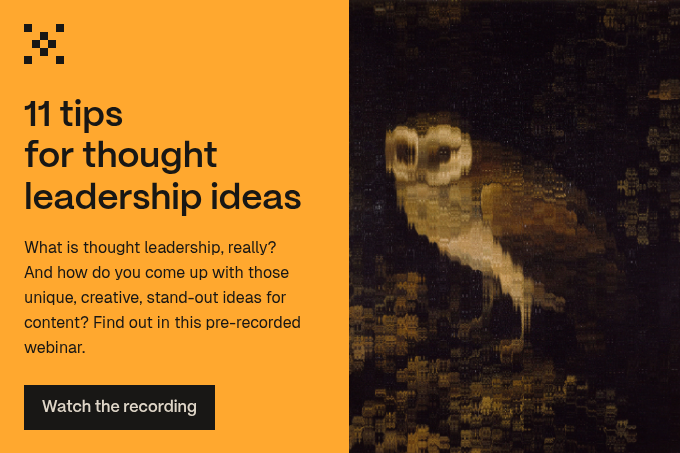There are two words that every writer needs to know if they're going to learn how to write well: lede and kicker. Most writers will be familiar with these, but in case the terms are new to you, let’s define them.
A ‘lede’ is the punchy opening sentence of an article. A ‘kicker’ is the last.
If you can get them right, you can elevate your writing to a whole new level. In this article, we’ll explore how to improve your starting sentences and ending points to keep modern, online audiences engaged — from start to finish.
Five tips for a great lede
Get them interested, hook them in, and slow the scan, scroll or mouse click that’s desperately trying to take them away. The lede needs to do all of this and more — while being short and snappy and not giving too much away. So, how can we achieve this?
"It was a bright cold day in April, and the clocks were striking thirteen.” - 1984 by George Orwell
Okay. The first line of every blog post, eBook or report can’t always be an Orwellian classic that turns an everyday event into something extraordinary. But it can be just as attention-grabbing. Here’s how.
- Open with a quote. Context? Check. Credibility? Check. Memorability? Check. Quotes are a great way to set the scene, whether you’re writing about your business, new technology, or a current trend. An impressive article from The Economist that we love begins:
“‘The world’s attention is back on your cause.’ That was Bill Gates talking to agricultural scientists…”
- Write 50 draft ledes and pick the best one. This is great advice from Writing to Deadline by Donald Murray. While writing 49 ledes that you won’t use might seem like a waste of time, it’s a great exercise to help you find the intro that best fits the piece (and make sure a first-draft quality lede never makes the final cut.)
- Establish a sense of person. Humans are curious by nature. Try shedding a light on a person in your lede, and give a sense of place and time, too, if it helps provide extra value. This Vanity Fair article written by Rosemary Counter does a great job of this. Very quickly, we know everything we need to know about the subject, Mayim Bialik, and which part of her interesting life this article will explore in detail.
Mayim Bialik has three decades of steady success on screens big and small, a neuroscience PhD, an adorable family with two teenaged boys, a sweet gig hosting Jeopardy! alongside Ken Jennings, and a hunky Canadian partner—both personal and professional—in Jonathan Cohen, with whom she makes her popular pandemic-born podcast, Mayim Bialik’s Breakdown. She is not, however, actually having a breakdown.
This same approach can be applied to subject matter experts, business owners, customers — whoever you’re writing about. Not just celebrities!
It’s important to remember, however, that the lede doesn’t have to cover everything. Following an engaging lede, we have what is colloquially known as the ‘NUT GRAF’, a paragraph that explains the article in a nutshell. The five Ws, if you will. This is the value, the meat, the draw to keep going. The lede has piqued their interest, but nut graf gives us that all-important extra context.
- Start by stating a problem. As in this Wired review:
“Welcome to the future, where clean air is a luxury. Thanks to pandemics and wildfires, air purifiers have become the gotta-have-it home appliance.”
- Be witty. This is the great trick of humourists like P.J. O’Rourke or Clive James (both excellent writers). Wit doesn’t mean you can’t cover serious topics. Here’s a great example from P.J.
“I looked death in the face. All right, I didn't. I glimpsed him in a crowd. I've been diagnosed with cancer, of a very treatable kind. I'm told I have a 95% chance of survival. Come to think of it -- as a drinking, smoking, saturated-fat hound -- my chance of survival has been improved by cancer.”
Four tips for a great kicker
The reader has made it to the end of your article. That’s a sure-fire sign you’ve done something right. But the kicker is what takes an article from good to great — and what leaves the reader wanting more.
"After all, tomorrow is another day." - Gone with the Wind by Margaret Mitchell
Some say the perfect ending doesn’t exist. Margaret Mitchell begs to differ. This six-word kicker manages to encompass the protagonist’s resilient yet naive nature, themes that are explored throughout the novel, all while leaving readers on a hopeful, ambiguous cliffhanger. Here’s how you can mirror this.
- Encapsulate the emotional message of the piece. For example, Clive James does a brilliant job of this in his 2018 Guardian review of The Crown.
‘Soon, there will be new actors to play the Queen and her consort: and soon, in real life, the cast must also change. Some of you will be lucky enough to see it all happen. Meanwhile the rest of us can go on being reminded about what life was once like. It would take an incurably radical spirit to contend that the Queen, if only by handing out a few hundred thousand tinsel gongs to people whose loyal devotion might have been a bit more expensive to purchase on the open market, had not played a great part in holding things together. Some might say holding things back, but even a few of those will be glued to the screen. I wonder how it all turns out.’
- Turn the story around. If you’ve been formal, go relaxed. If you’re relaxed, become formal. The use of colloquial language amid a formal article might seem jarring, but at the end, it makes for a memorable twist. The below example from Wired does this well.
“It takes a clean digital signal from your USB port and converts it to a warm analog music. And it looks as badass as it sounds.”
- Use a metaphor. This is a great tactic for memorability. Try to include reference to the senses, paint a picture, refer back to earlier details that tie everything together. You can opt for short, snappy and simple, like the below from The Economist.
“Mr. Grubel may be counting on a return to the casino but if regulators have their way, it’s door will soon be shut.”
Or, you can try an extended metaphor, as Jia Tolentino from The New Yorker did. Her article on ‘Instagram face’ opens by describing the subject as ‘a face that looks like its made out of clay’. It ends with the following metaphor.
"If you worship perfection, you cannot appreciate the beauty in wreckage—on Instagram, the scavenger, too, will always find something to polish. But for now, this face is a compromise, a negotiation between what we might be and what we can't yet know. It is a girl face, of course, a sister to Audrey Hepburn's and Brigitte Bardot's; it exists at a threshold of time, a lovely mask, as we wait to see what happens next."
- Deploy a quotation. A snappy quote can encapsulate the theme of an article and give it extra life, as in this example from the New Yorker.
“’Last year, in Abu Dhabi, a man spent fourteen million dollars at a public auction for a license plate that had only one digit: ‘1.’ ‘I bought it because it’s the best number,"’ he said.”
- A simple call-to-action. When it comes to website content, blogging in particular, businesses often use it as a tool to drive traffic and generate leads. In turn, it’s common practices to end articles with a call-to-action (CTA) — sign-up, learn more, get in touch and so on. But be sure to re-iterate the value of the business, product, service that you’re writing about. And remember, a piece of well-written content will encourage the reader to take the next step without being prompted to do so. Your CTA should be a small nudge in the right direction, never a push.
There are a million different ways to start and end your articles. Experiment with different approaches and see what best suits your content and your brand overall. But if you take anything away from this article, remember this: a good lede invites you to the party, and a good kicker makes you wish you could stay longer.
This article was first published in November 2009 and we updated it, with input from Sian Cooper and the rest of the writing team in September 2024.
.jpg?width=1600&height=800&name=europeana-KG61l7RNWBs-unsplash%201%20(1).jpg)





